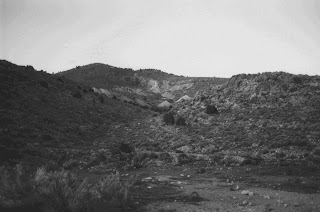
Once one of southeastern Nevada’s most prominent mining camps, Delamar has suffered as much abuse and neglect as any ghost town in the state.
The town’s story began in 1890-91, when farmers from the Pahranagat Valley in eastern Nevada uncovered gold in the area. By 1892, the Ferguson Mining District was established and miners from nearby Pioche began prospecting the area.
A year later, Captain John De Lamar of Montana acquired most of the principal claims in the district, which was renamed after him (although it was later changed slightly to Delamar).
De Lamar invested in the district, which between 1895 and 1900 was the most productive mining area in the state. A post office was opened in 1894 and within three years the camp had grown into a full-scale town with about 3,000 residents, shops, saloons, hotels, a hospital, churches and a newspaper, The De Lamar Lode, which continued publishing until 1906.
Delamar, however, soon gained notoriety as a very dangerous place to work. Water was scarce and the dry drilling techniques used to extract gold from the rock generated a fine silica dust (called the Delamar Dust) that resulted in silicosis, a painful and ultimately fatal lung disease.
In fact, many miners began referring to Delamar as “the Widow Maker” because of the high death rate.
Despite its deadly reputation, the town thrived because local mine owners paid exceptionally high wages for the time, $3 per day.
Additionally, by the late 1890s, Nevada was experiencing a statewide mining slump—Virginia City and Austin had ceased producing much ore while Tonopah and Goldfield were yet to be discovered—so many miners were eager for work.
Eventually, a water pipeline was installed to carry water from Meadow Valley Wash, located 12 miles north. The arrival of a reliable water source finally improved working conditions in the mines but not soon enough for those who were afflicted with lung disease.
About half of Delamar was destroyed by fire in 1900. The town was rebuilt but two years later De Lamar sensed the boom was over and sold his mining interests. New owners continued operations until about 1909.
During its decade-and-a-half of operations, Delamar generated more than $13 million in gold.
With its principal industry closed, Delamar began a quick decline. Although there were periodic revivals of the mines, the district proved to be played out.
Photographs from the 1950s show that Delamar still contained fairly substantial ruins up to that time. Local folks recall that until the 1960s, visitors to Delamar could still find a house with a piano and partial furnishings, as well as a saloon that contained liquor bottles that had been partially melted by fire.
But during the next two decades, souvenir-hunters discovered Delamar and hauled out nearly anything that could be removed. Even some of the headstones at the Delamar cemetery (which is still there, north of the town site) were taken.
Today, Delamar has been reduced to a handful of stone foundations and partial buildings peeking through the sagebrush. Below the town site are thick wooden beams that were once part of the local stamp mill.
The hillsides around the town are littered with tailing mounds and there is a large depression, which appears to have once been the site of considerable mining activity, which can be seen near the top of the mountain that overlooks the town.
Delamar is located about 28 miles southwest of Caliente via U.S. 93 and a marked, four-wheel drive gravel and dirt road. You drive about 15 miles on the dirt road, through a forest of Joshua trees, before reaching the site. The road is not recommended for passenger cars.
For more information, check out http://www.ghosttowns.com/states/nv/delamar.html.




I remember seeing the Widow Maker in 1989...we were touring the U.S. on a Harley. Now how the hell did we get there on a bike?!
ReplyDelete